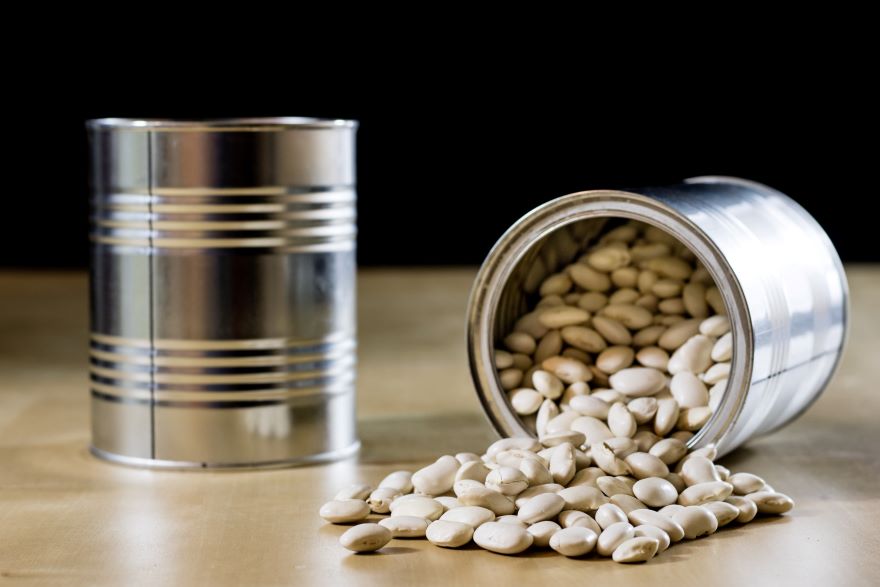Canned white beans are an incredibly versatile pantry staple I often turn to for a quick, healthy, and satisfying meal. These beans come already cooked, which makes them a convenient choice for busy evenings when I still want to eat something nutritious but don’t have much time to spare. With their creamy texture and mild flavor, they are a wonderful addition to a variety of dishes, ranging from hearty stews to refreshing salads. A touch of garlic and a drizzle of olive oil can elevate a simple can of white beans into a dish that is both cozy and flavorful.

One of my favorite things about canned white beans is their nutritional profile. They are a great source of plant-based protein and fiber, contributing to a balanced diet. When I incorporate them into my cooking, I’m not just saving time; I’m also infusing my meals with health benefits. Whether I’m blending them into a smooth white bean dip or adding them to a cozy white bean stew, these beans seamlessly integrate into recipes from across the globe, demonstrating their culinary adaptability. Plus, knowing how to properly store and prepare canned beans can ensure I always have a convenient ingredient ready to enhance my meals.
Key Takeaways
- Canned white beans are a timesaving ingredient for healthy, home-cooked meals.
- They provide nutritional value and adapt to diverse recipes.
- Proper storage and preparation of canned beans maximize their convenience and flavor.
The Nutritional Profile of Canned White Beans

Canned white beans offer a convenient and nutritious addition to various diets, providing essential nutrients like fiber and plant-based protein, which contribute to a healthy eating pattern.
Comparing Different Types of White Beans
Great Northern beans and navy beans both fall under the category of white beans, yet they differ slightly in size and taste. Great Northern beans are larger and have a nutty flavor, while navy beans are smaller and have a denser structure. These variations don’t significantly impact their nutritional content; both are excellent sources of nutrients and fit well into a plant-based diet.
Fiber and Protein Content
Fiber: A pivotal nutrient in white beans is dietary fiber. A can of white beans can provide a substantial amount of an individual’s daily fiber needs, aiding in digestion and contributing to cardiovascular health.
Protein: As a plant-based protein source, canned white beans serve as a significant contributor to daily protein intake. Beans like Great Northern and navy beans not only provide protein but are also versatile in various recipes, from salads to soups.
These nutrients, along with others such as iron, which is more bioavailable in white beans compared to red beans, according to studies, make canned white beans a nutritious choice for individuals seeking a healthful plant-based food option.
Culinary Uses in Diverse Recipes
Canned white beans are a versatile ingredient that can transform any meal. Packed with nutrients, they blend well in various recipes, offering a fine balance between health and flavor.
Incorporating Beans into Main Dishes
I find that white beans are extremely adaptable in main dishes and can absorb a range of flavors. For instance, a white bean cassoulet is a hearty option that only needs about 30 minutes of prep time. The beans provide creaminess once mashed, adding texture to the dish.
Creating Flavorful Side Dishes
As a side dish, white beans elevate the flavors of simple ingredients such as vegetables and herbs. A classic example is a salad combining white beans with roasted bell peppers and blue cheese, hinting at a fusion of traditions as seen in Bulgarian-inspired recipes. It’s simple and can be served either warm or cold.
Quick and Easy Snacks
Finally, white beans are my go-to for whipping up snacks in a flash. You can top toast with a savory bean spread, mixing in spices and citrus for a refreshing vegan treat. These bean recipes are not only quick to prepare but also customizable to your palate, whether you crave something spicy or tangy.
Convenient Cooking Techniques with Canned Beans
Canned beans offer a versatile and quick solution to preparing a range of dishes. Here, I’ll share some of my favorite techniques to turn these pantry staples into delicious meals efficiently.

Creating Quick Meals
With canned beans, I always have an essential ingredient ready for a rapid meal. Salads become a breeze by adding beans to cherry tomatoes, fresh herbs, and a dash of olive oil, creating a hearty dish in minutes. Soups also benefit substantially; stirring beans into a vegetable soup thickens it and adds protein.
- Bean Salads: Combine beans with diced vegetables, such as onions and cherry tomatoes, and toss with a vinaigrette.
- Bean Soups: Stir beans into a simmering pot of soup for extra heartiness.
Tips for Enhancing Flavor
To make the most out of canned beans, it’s essential to enhance their flavor. I start with sautéing garlic and onions in olive oil until they’re fragrant. This creates a garlicky base that infuses the beans with deep flavors.
- Sauté:
- Heat olive oil on medium.
- Add minced garlic and chopped onions; sauté until golden.
- Herbs:
- Mix in herbs like rosemary or thyme during the last few minutes of cooking to retain their aroma.
Employing these techniques, I ensure that my canned beans-based meals are not only quick to prepare but also rich in flavor and appeal.
Health Benefits of Incorporating Canned White Beans
Canned white beans are not only convenient but also a treasure trove of nutritional benefits, seamlessly fitting into a balanced diet and supporting digestive health.
Contributing to a Balanced Diet
I find canned white beans to be an excellent source of plant-based protein, making them a staple in vegan and vegetarian diets. Just one cup of these beans provides a significant amount of the daily protein requirement. Moreover, they are low in fat and contain essential vitamins and minerals like potassium and magnesium that contribute to overall health. Their versatility in various recipes ensures that meeting dietary recommendations for bean intake is both simple and delicious, especially for those seeking healthy eating options on a budget.
Impact on Digestive Health
The high fiber content in canned white beans is beneficial for digestive health. Fiber aids in regular bowel movements, reducing constipation, and may help to prevent gastrointestinal disorders. A diet rich in fiber from beans can also be instrumental in blood sugar regulation, as it slows down the absorption of sugar into the bloodstream. This can be particularly advantageous for individuals managing their blood glucose levels, or for anyone interested in maintaining their energy levels and mood.
As with all foods, some people may have sensitivities or allergies to specific bean types. It’s important to be aware of such issues, especially when introducing beans to children’s diets.
Tips for Storing and Preparing Canned White Beans
In my experience, the keys to fully enjoying canned white beans lie in proper storage before use and imaginative preparation techniques. Here’s how I ensure they stay fresh and taste great every time.
Maximizing Shelf Life
I always keep my canned white beans in a cool and dry area of the pantry. I make sure the temperature is ideally between 50-70°F. This range is crucial for maintaining the quality and flavor of the beans. Keeping them organized and rotated is also a good practice; I use the older cans first. For those instances where I have leftover beans, I like to freeze them. Freezing white beans can extend their usefulness, but I ensure they are in an airtight container to prevent freezer burn.
Preparation Ideas for Optimal Taste
When preparing white beans, I begin by draining and rinsing them to remove excess sodium. Then, I typically sauté garlic and rosemary in olive oil, adding the beans to infuse them with these aromatic flavors. This method brings a savory depth to the beans that works wonders in salads or as part of a more substantial dish. If there are leftovers, reheating them is straightforward; I gently reheat on the stove with a splash of water to keep them moist. White beans are durably versatile pantry staples that can adapt to various recipes, making them a powerhouse ingredient in my kitchen.
Frequently Asked Questions
In this section, I’ll address some of the most common inquiries regarding canned white beans, including their preparation, nutritional value, and uses in recipes.
What are the nutritional benefits of canned white beans?
Canned white beans are rich in protein, fiber, and essential nutrients like iron and potassium. Their high fiber content can help in maintaining good digestive health, while the presence of antioxidants supports overall well-being.
How to prepare a simple canned white bean recipe?
To prepare canned white beans, sauté them with aromatics like garlic and onions. Then, add herbs and seasonings for flavor. For specific instructions, refer to the method detailed on Loaves and Dishes, which suggests using bacon for added depth.
What are some popular dishes that pair well with white beans?
White beans are versatile and can complement many dishes, such as hearty stews, refreshing salads, and robust pasta plates. They seamlessly integrate with vegetables, meats, and other legumes to create balanced meals.
Are canned white beans and cannellini beans the same?
Canned white beans can refer to various types, including cannellini beans. Cannellini beans are a specific variety of white bean known for their larger size and firmer texture, making them great for recipes that require beans to hold their shape.
Can you consume canned white beans without cooking them?
Yes, canned white beans are pre-cooked and can be consumed without further cooking. Remember to rinse them before consuming to remove excess sodium and any preservatives.
Where can one purchase canned white beans?
Canned white beans are widely available and can be purchased at supermarkets, grocery stores, and online retailers. They’re a staple item in the canned goods aisle and come in different brand choices.

*We may earn a commission for purchases made using our links. Please see our disclosure to learn more.



